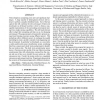905 search results - page 109 / 181 » Active Learning for Pipeline Models |
NN
2002
Springer
13 years 7 months ago
2002
Springer
Recognition-by-components is one of the possible strategies proposed for object recognition by the brain, but little is known about the low-level mechanism by which the parts of o...
NIPS
2004
13 years 9 months ago
2004
Areas of the brain involved in various forms of memory exhibit patterns of neural activity quite unlike those in canonical computational models. We show how to use well-founded Ba...
SASO
2008
IEEE
14 years 2 months ago
2008
IEEE
Truly ubiquitous computing poses new and significant challenges. A huge number of heterogeneous devices will interact to perform complex distributed tasks. One of the key aspects...
BC
2002
13 years 8 months ago
2002
Hebb's original postulate left two important issues unaddressed: (i) what is the effective time window between pre- and postsynaptic activity that will result in potentiation?...
ICONIP
2009
13 years 5 months ago
2009
To achieve sustainable human-agent interaction (HAI), we proposed a new model of intrinsically motivated adaptive agent, which learns about the human partner and behaves to satisfy...

